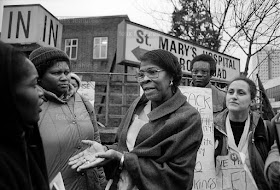 On December 17th the Defence Committee of St. Mary's Hospital, Harrow Road, held a press conference at which Tony Benn and Ken Livingstone declared their full support for the struggle of the staff to defend their hospital against the loss of 100 beds and eventual closure.
On December 17th the Defence Committee of St. Mary's Hospital, Harrow Road, held a press conference at which Tony Benn and Ken Livingstone declared their full support for the struggle of the staff to defend their hospital against the loss of 100 beds and eventual closure.St. Mary's, Harrow Road, has been under threat for the last four years and in the past only the vigorous opposition of the staff has prevented its total closure;
The hospital serves the Paddington and Kilburn area and local residents have seen the decision to close "their" hospital and move surviving services to the prestigious St. Mary's Teaching Hospital in Praed St.
The press conference heard Terry Pettifor, NW Convenor of the London Ambulance Service Shop Stewards, describe the effects of the run down of the Casualty at Harrow Road (which is the major accident unit in the District) and pointed out that the remaining casualty facilities in the District are inadequate to cope with the number of casualties which could easily arise in an accident at the nearby Paddington Station or in a major fire.
Terry pointed out that a relatively small fire in Bayswater the week before had stretched the District's capacity to the full.
The fight in the hospital has been particularly sharp since the declaration- of a work-in on June 26 1981 . In the course of this fight staff have twice occupied areas of the hospital—the first time the administration offices were occupied for 13 days and the second time a ward was occupied for five days to prevent closure. On both occasions court orders were used to evict.staff.
Police and security guards have been brought into the hospital no less than four times to support management's plans. A TGWU shop steward was sacked, and a nurse was suspended for a week, for attempting to prevent the forcible removal of patients from a ward.
Throughout this struggle no more than token support has been gained from the unions involved-TGWU, NUPE, COHSE and the failure of the labour movement to evolve its own strategy on health care has been partially responsible for this state of affairs.
The leadership of the TGWU-which has been most centrally involved in the struggle—has effectively washed its hands of any responsibility. Despite policy won at the 1981 BDC it has consistently refused to mobilise its great industrial strength behind this key battle.
With a few honourable exceptions there has also been little support from CLPs outside Paddington. It is essential that the labour movement begins to evolve its own strategy to defend and extend the principle of free and adequate health care for all which was enshrined in the formation of the NHS by the 1945-51 Labour government.
It is impossible to see the defence of the NHS without the political mobilisation of the labour movement as a whole to defend our health service—any narrow economism of "leave it to hospital trade unionists" merely puts the onus on the weaker sections of our movement.
The Labour Party must see the fight for health as being one of the key questions that faces it. It is not enough to ritually denounce private practice if we lack the political answers and will to mobilise the community around this key question.
There is undoubtedly a move towards smashing the growth of trades unionism within the NHS. Julian Nettel who is now at St. Mary's was involved in the closure of St. Benedict's. In the last two years
over 20 militants have been victimised out of the NHS. In St. Mary's, Rita Maxim, a TGWU shop steward who has Stood up to management all the way, faces the sack for refusing to do two jobs.
Management obviously intend to continue this strategy in St. Mary's now they have succeeded in closing the first three wards in the hospital. They have also sacked a telephonist for leaving work at the end of his shift without waiting for a relief.
Trades unionists in the hospital realise they have lost the first battle but the war is far from lost. Help us fight to win.
Send donations and messages of support to Mick Woods, c/o TGWU Office, St. Mary's Hospital, Harrow Road, London W9.
Mick Woods, Brent E. CLP and former TGWU shop steward St. Mary's Hospital.












 :
: